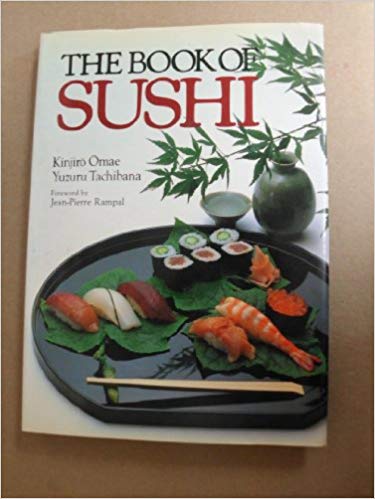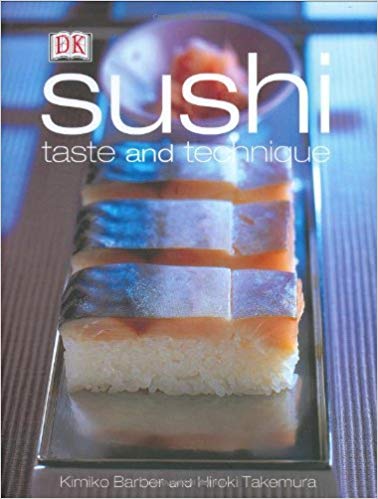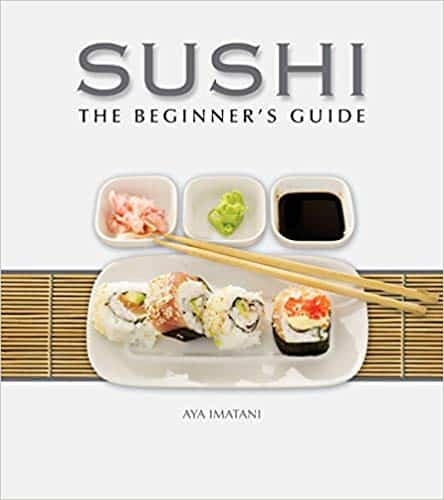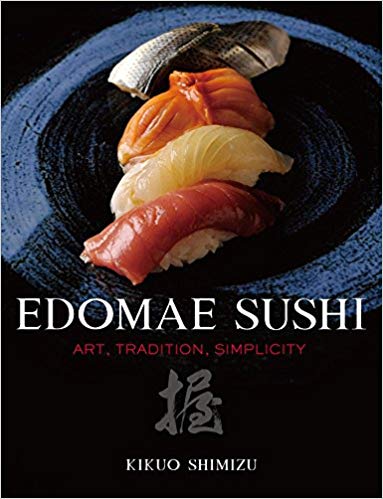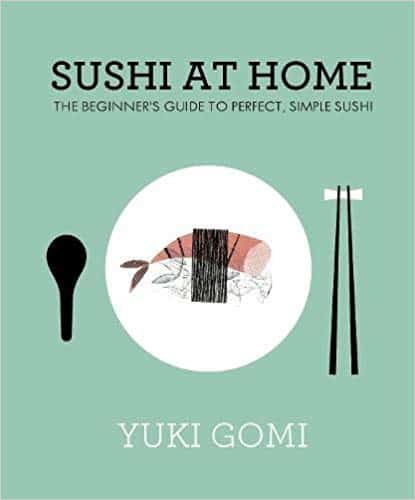Sushi for Beginners | a little history & the best get started guides
Sushi (すし, 寿司, 鮨) is a world-renowned Japanese cuisine that has a variety of ingredients. It’s made with vinegared rice (鮨飯 sushi-meshi), which is often accompanied by sugar and salt to balance the flavors.
It is filled with vegetables, seafood, meat, and sometimes tropical fruits.
There is a variety of sushi preparations (styles), but the one thing that’s common between all of them is the shari (しゃり), or sumeshi (酢飯) or otherwise known as “sushi rice.”
In this article, we’ll share the history of sushi and all the important information you need to know about this tasty dish!
So, the next time you find yourself at a sushi restaurant, you’ll know exactly what to order and how to eat it.
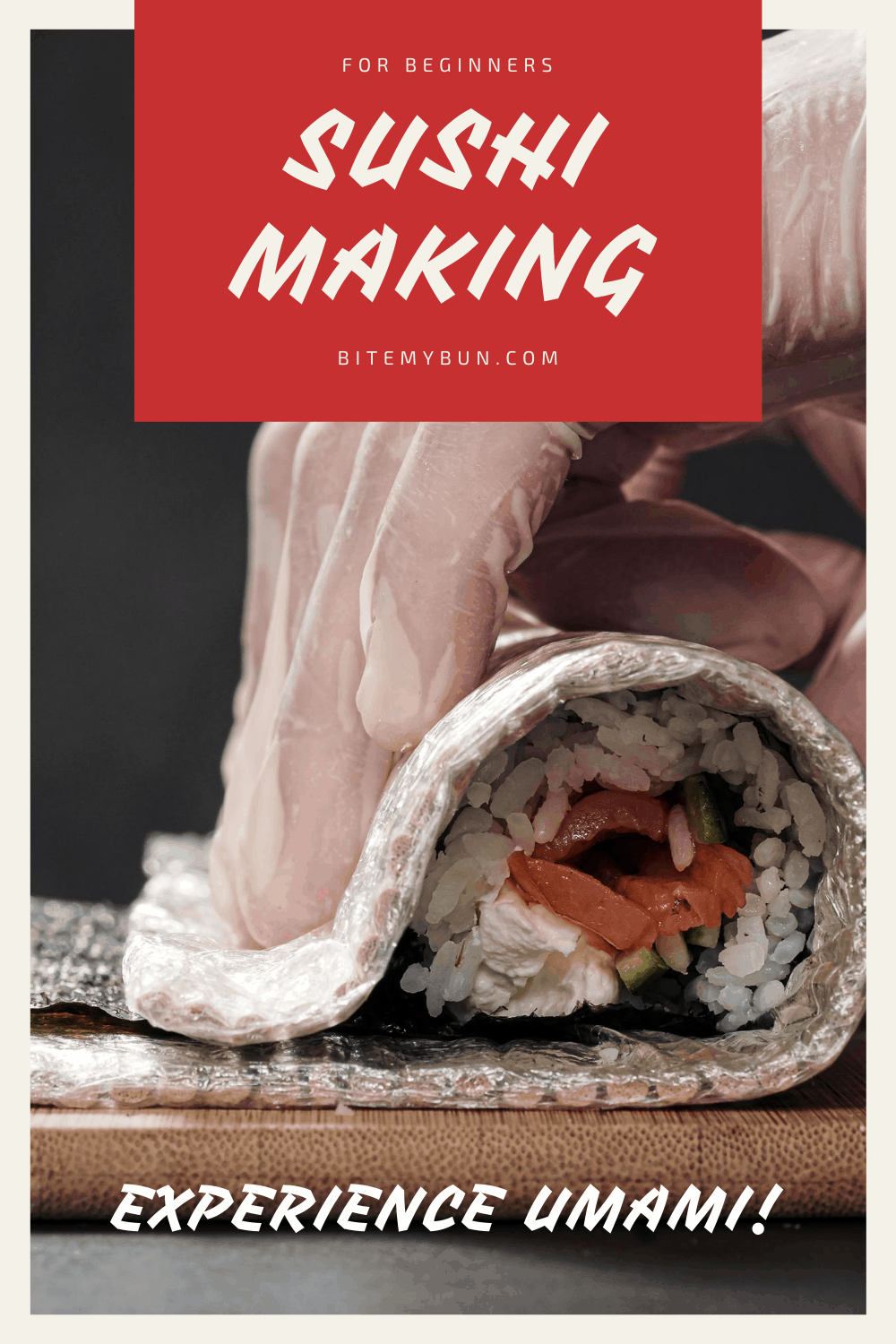

Check out our new cookbook
Bitemybun's family recipes with complete meal planner and recipe guide.
Try it out for free with Kindle Unlimited:
Read for freeIn this post we'll cover:
An Introduction to Sushi
In ancient times sushi preparations and presentations were strictly made with medium-grain white rice, but in modern times people tried to variate it with short-grain or brown rice.
So, you’re wondering what sushi rolls look like and how many pieces a roll comes in?
Well, basically a sushi roll is a small piece of fish, meat, or, vegetables wrapped in vinegared rice and a sheet of seaweed called Nori paper.
Seafood such as imitation crab meat, tuna, salmon, yellowtail, eel, or squid is essential meat side dishes for the sushi.
A significant number of sushi types lean towards vegetarian ingredients. These vegan sushi dishes are usually served with soy sauce, wasabi, and pickled ginger (gari).
Daikon radish or pickled daikon (takuan) are popular garnishes for the dish.
People often get confused between sushi and sashimi, although it is understandable as most of their ingredients look eerily similar.
If you want to take sushi making to the next level, I’ve found that this comprehensive video course on Udemy is great for getting started. It’s also a good way to get more out of your knowledge for some amazing recipes.
It has over 40 videos to take you step-by-step through the sushi-making process. Go check it out!
And also read on for more on the different kinds of sushi and some other guides and resources to get you started.
Also read: these are the knives you’ll love when making sushi
History of Sushi
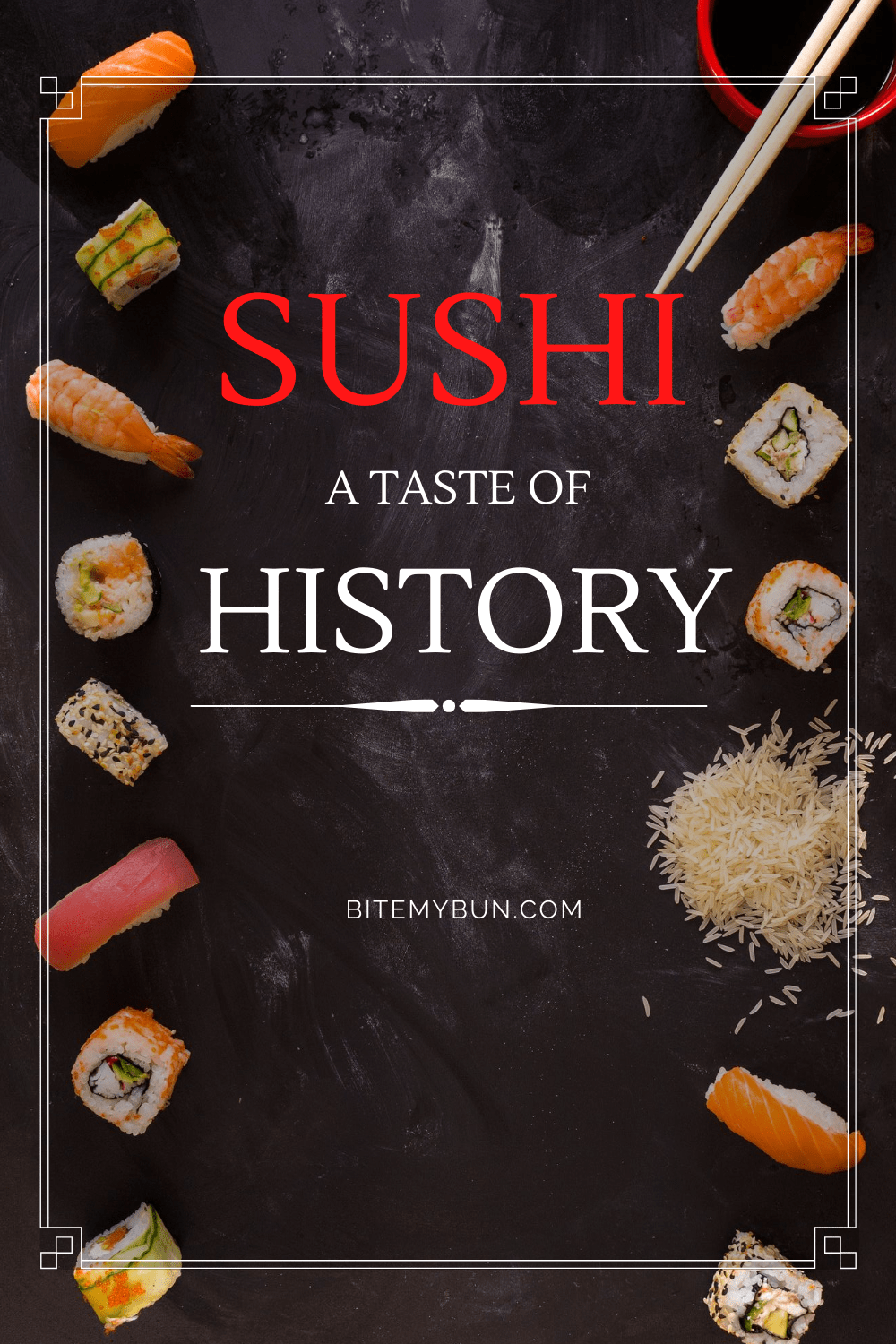
Sushi is a variation of an old Japanese cuisine called narezushi (馴れ寿司, 熟寿司 – “salted fish”) where the process involved in making it is to store the fish for months at a time in fermented rice.
According to legend, sushi was invented by accident. There is a popular Japanese legend about an old woman who hid her pots of rice in osprey nests to hide the food from thieves.
After some time, she took out the pots only to realize the rice had fermented. Some of the osprey’s fish scraps had fermented and mixed with the rice and it tasted good.
Although this might be a story, fermented rice was already mentioned in writing in 4th century China.
What actually happens is that rice would undergo a process called lacto-fermentation, which preserves the fish and doesn’t allow it to spoil.
When the fish is ready to be consumed, the rice is discarded as it no longer has any use.
Sushi literally means “sour-tasting,” but this term is an old Japanese word that is no longer used today in any context.
Sushi that has dashi stock in its seasonings or sauces enhances the overall sourly taste of the dish because it adds umami flavors to it.
Regional Variations
In the Shiga Prefecture, people still enjoy their regional specialty, narezushi, although it is called funa-zushi nowadays.
During the Muromachi Era (1336–1573) Japanese food experts thought that they had to add vinegar to the narezushi with the purpose of preserving and enhancing the dish – it became known as the “oshi-zushi” or “hako-sushi” which is commonly called today as Osaka-style sushi.
Aside from making the rice taste more sourly, the vinegar also aided in the longevity of the dish. This caused the makers of sushi to first shorten the fermentation process and eventually abandon it altogether.
Over the centuries, Osaka is the place where the primitive sushi had undergone several improvements and the sushi rolls would first appear.
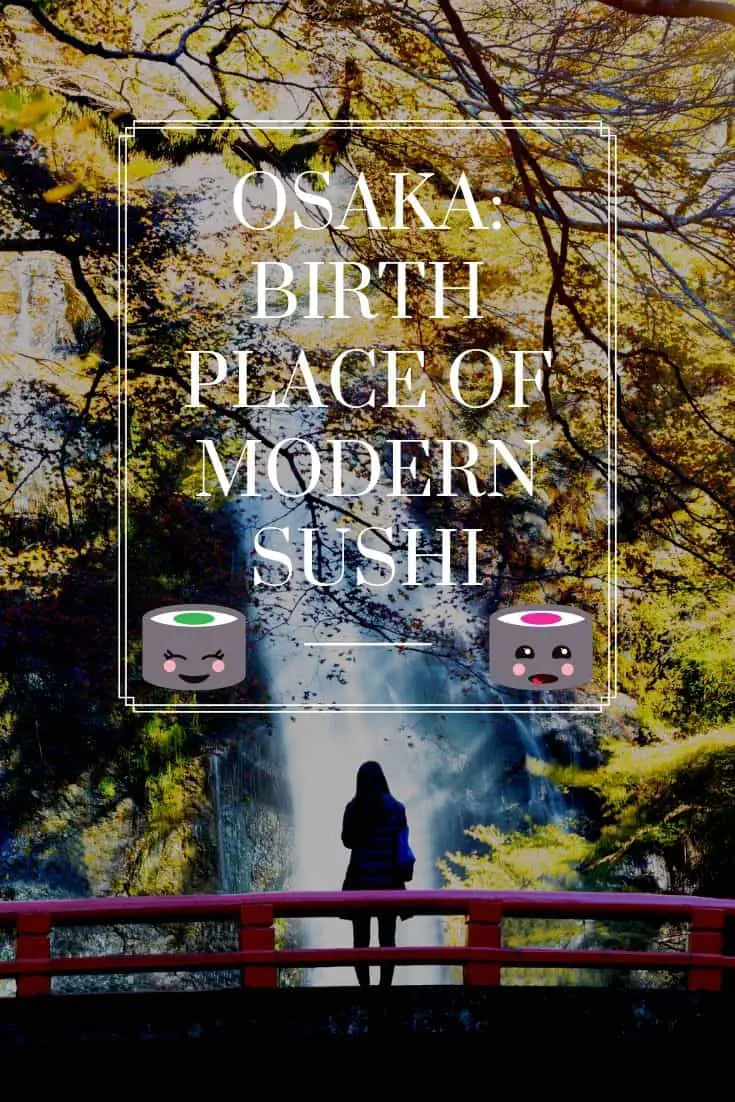
Modern Sushi
So, when was the modern-day sushi roll invented? Well, it took a long time until sushi became what it is today.
It was not until the Edo Period (1603–1868) that fresh fish was served over vinegared rice and nori.
The modern nigirizushi had its origins in Edo (modern-day Tokyo) during the 1820s – 1830s.
According to a recurring story about the origins of nigirizushi, a Japanese chef by the name of Hanaya Yohei (1799–1858) either invented or perfected the sushi-making technique at his restaurant in Ryōgoku in 1824.
Nigirizushi was originally called Edomae zushi (zushi not sushi), because chefs would use freshly caught fish from Edo/Tokyo Bay (江戸江 Edo-mae in Japanese).
Chefs would still call it Edomae nigirizushi even to this day as it signifies the high quality of the sushi, regardless of where the fish or other ingredients come from.
Types of Sushi
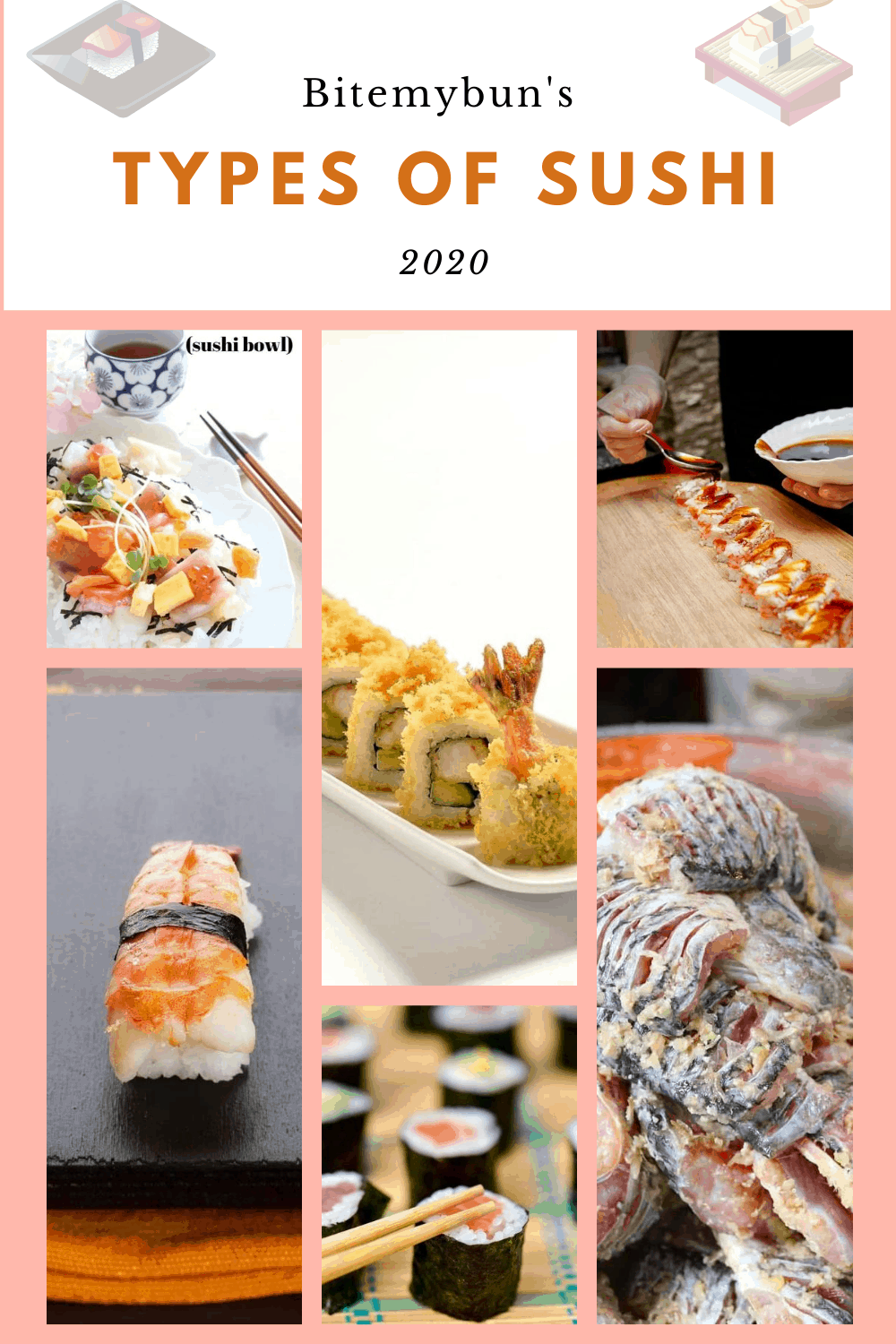
Central to the sushi’s ingredients no matter where or when (the Japanese have a tradition of preparing meals with varying ingredients based on seasons) is how the vinegared rice is prepared.
Fillings, toppings, condiments, and preparation vary widely.
The mutation of the consonants in the Japanese language which is known as rendaku (連濁), sushi is then spelled with “zu” and not what the Western vocabulary designates it with the “su” when a prefix is linked to it (e.g. nigirizushi).
You can also read our in-depth post about the types of sushi.
Chirashizushi (sushi bowl)
Chirashizushi (ちらし寿司) is also called barazushi or “scattered sushi.”
The chef places the rice in a bowl instead of wrapping it around the different ingredients. Then, the chef garnishes it with fish and vegetable toppings.
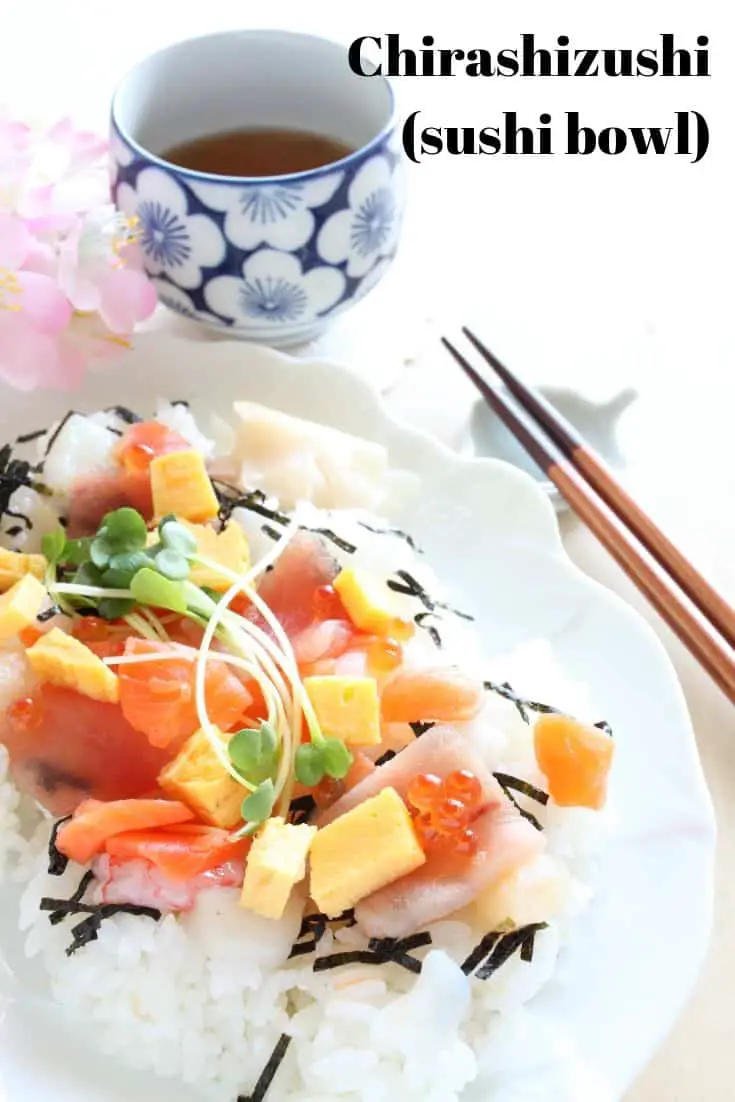
It is an annual dish eaten during Hinamatsuri in March. People love to eat it because it’s easy to prepare and it can make you full with just 1 meal.
Edomae Chirashizushi (Edo-style scattered sushi) is a variation of the chirashizushi that is served with raw ingredients arranged in artistic rendering.
Gomokuzushi (Kansai-style sushi) is another variation of the chirashizushi that has raw or cooked ingredients mixed in a bowl or plate of rice.
Sake-zushi (Kyushu-style sushi) ferments the cooked rice with rice wine (mirin) instead of vinegar. Then it’s garnished with shrimp, sea bream, octopus, shiitake mushrooms, bamboo shoots, and shredded omelet toppings.
Inarizushi
Inarizushi (稲荷寿司) is a type of sushi named after the Shinto god Inari. It’s packed in a pouch made out of fried tofu with rice in it.
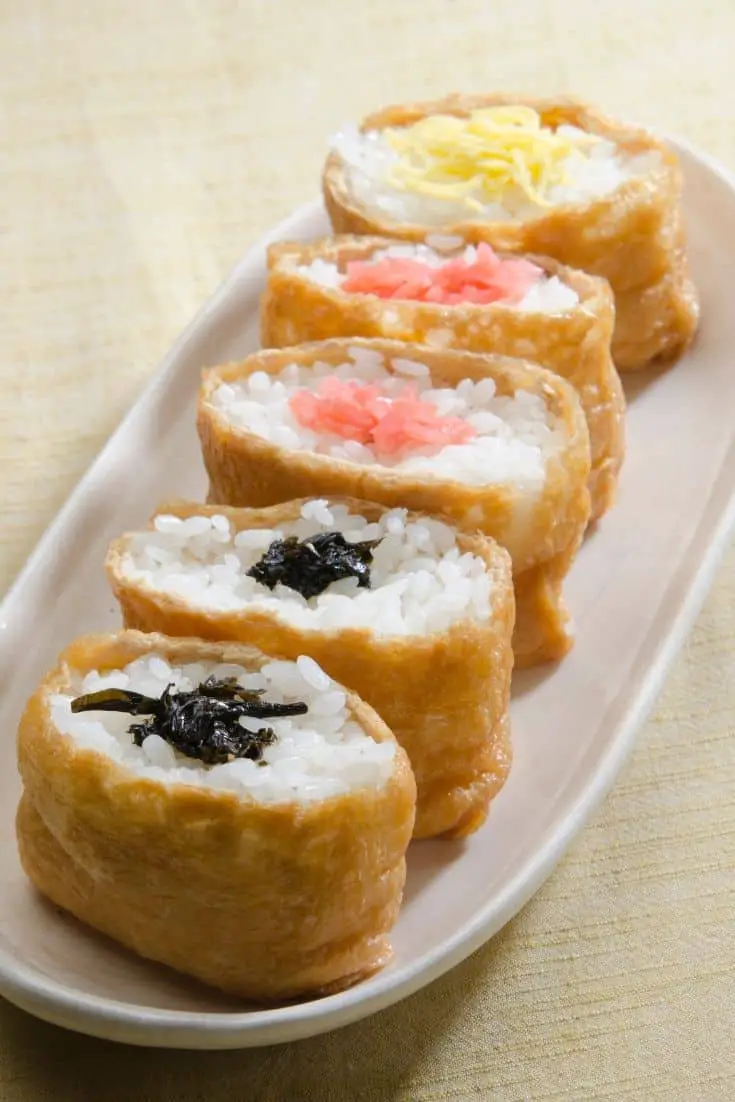
In Japanese legends, the foxes were the messengers of the god Inari and according to the tale they like fried tofu a lot.
This is the reason why the Inari-zushi roll has pointed corners in order to symbolize fox ears like a call back to Inari’s fox messengers.
Some regional variations of the inarizushi have pouches that are made of the thin omelet in place of the fried tofu, they are called fukusa-zushi (帛紗寿司), or chakin-zushi (茶巾寿司).
Makizushi
Makizushi (巻き寿司) is the famous rolled sushi with varying names like the nori roll (海苔巻き) and variety of rolls (巻物).
It looks like a cylindrical piece of food that is reminiscent of electrical tape in both shape and size. It’s formed using a makisu (巻き簾) or bamboo mat.
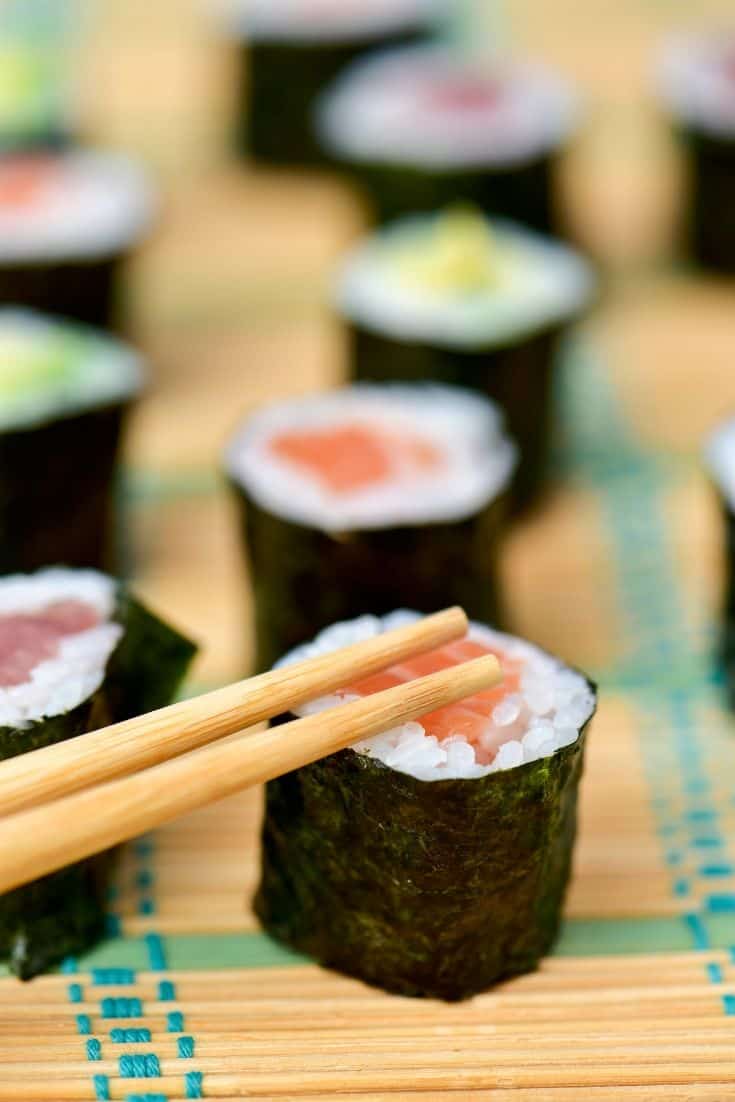
The makizushi is normally wrapped in nori (seaweed), but sometimes can also be wrapped with other elements including shiso (perilla) leaves, cucumber, soy paper, and thin omelet.
The chef would cut the makizushi into 6 – 8 pieces of two-thirds of an inch thick from a single roll order.
Types of Makizushi
We’ve listed some of the most common types of makizushi that you can find in most Japanese restaurants; however, there are more kinds of makizushi than these.
- Futomaki (太巻, “thick, large or fat rolls”)
- Tamago Makizushi (玉子巻き寿司)
- Tempura Makizushi (天ぷら 巻き寿司) or Agezushi (揚げ寿司ロール)
- Hosomaki (細巻, “thin rolls”)
- Kappamaki, (河童巻)
- Tekkamaki (鉄火巻)
- Negitoromaki (ねぎとろ巻)
- Ehōmaki (恵方巻, “lucky direction roll”)
- Temaki (手巻, “hand roll”)
Modern Narezushi
Narezushi (熟れ寿司) also called “matured sushi” is one of the well-known traditional fermented sushis in Japan.
Making the sushi starts with skinning and gutting freshly caught fish, and then stuffing them with salt.
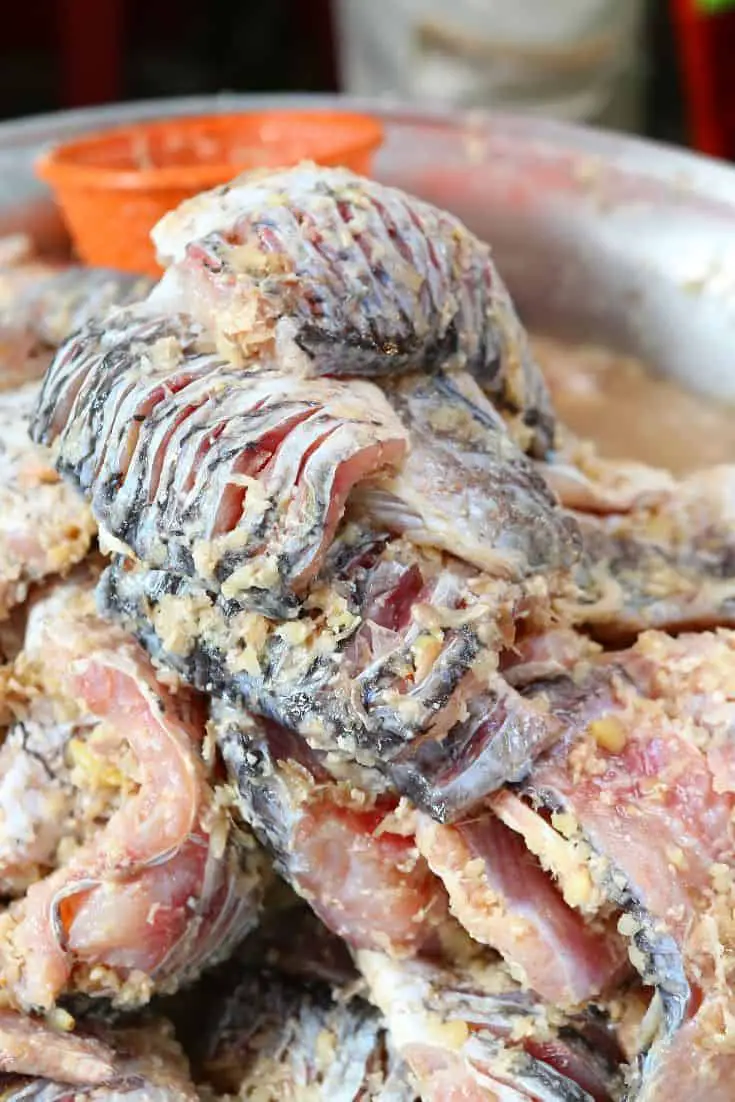
They are then placed in a wooden barrel and drenched in salt a second time. Then, a pickling stone called “tsukemonoishi” is placed on top of the barrel to weigh them down.
Each day all the moisture is removed from the barrel.
The fish ferments for about 6 months’ time before it’s taken out and eaten.
Since it is now fermented, then it will last for another 6 months or more and will not spoil.
The funa-zushi is the most famous variety of narezushi which is a specialty dish of Shiga Prefecture.
This sushi is made with the nigorobuna, a goldfish from the crucian carp genus, and is endemic to Lake Biwa.
Nigirizushi
Nigirizushi (握り寿司, “hand-pressed sushi”) otherwise known as “hand-pressed sushi.” The chef scoops a handful of rice and squeezes it in his palms to form an oblong/oval-shaped sushi rice with neta toppings.
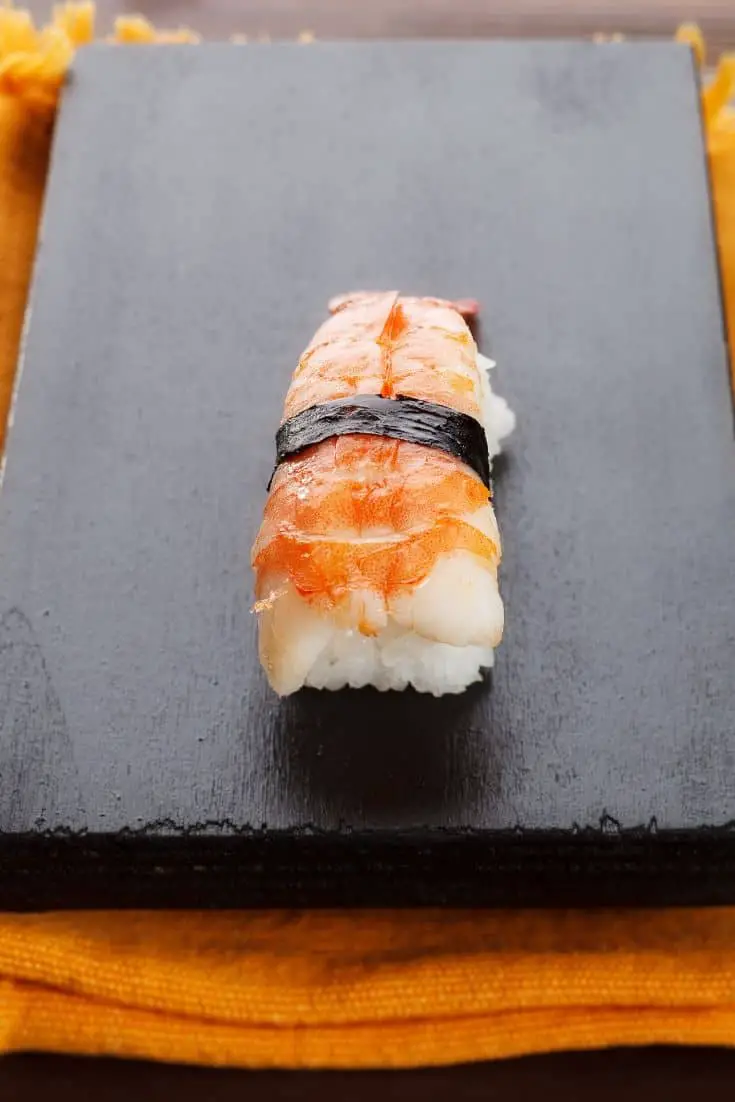
The nigirizushi is commonly served with a tablespoon of wasabi. The neta could consist of tuna, salmon, other types of fish, or seafood.
Some toppings are also wrapped around the rice using a thin strip of nori. These include sweet egg (tamago), squid (ika), sea eel (anago), freshwater eel (unagi), and octopus (tako).
One order of a given type of fish typically results in two pieces, while a sushi set (sampler dish) may contain only one piece of each topping.
Gunkanmaki (軍艦巻) also called “the warship roll” is oval-shaped sushi rice that has a strip of nori wrapped around its external portion. It has a fun shape that almost resembles a battleship.
The oblong sushi rice is filled with soft, loose, or fine-chopped ingredients. These include quail eggs, scallops, corn with mayonnaise, sea urchin roe (uni), oysters, natto, and roe.
It’s significant as this type of sushi which is a variation of the nigirizushi was invented at the Ginza Kyubey restaurant in 1941.
It was also because of the gunkanmaki that the use of soft toppings in sushi was revolutionized.
Another variation of the nigirizushi is the temarizushi (手まり寿司) or “ball sushi.” This one is molded into a spheroid shape, unlike the oval-shaped gunkanmaki.
Also read: these are the different calorie counts for the 11 most popular types of sushi
Oshizushi
Oshizushi (押し寿司) “pressed sushi,” also known as hako-zushi (箱寿司) “box sushi,” is hand-pressed sushi that originated from the Kansai region and is a favorite and a specialty of Osaka.
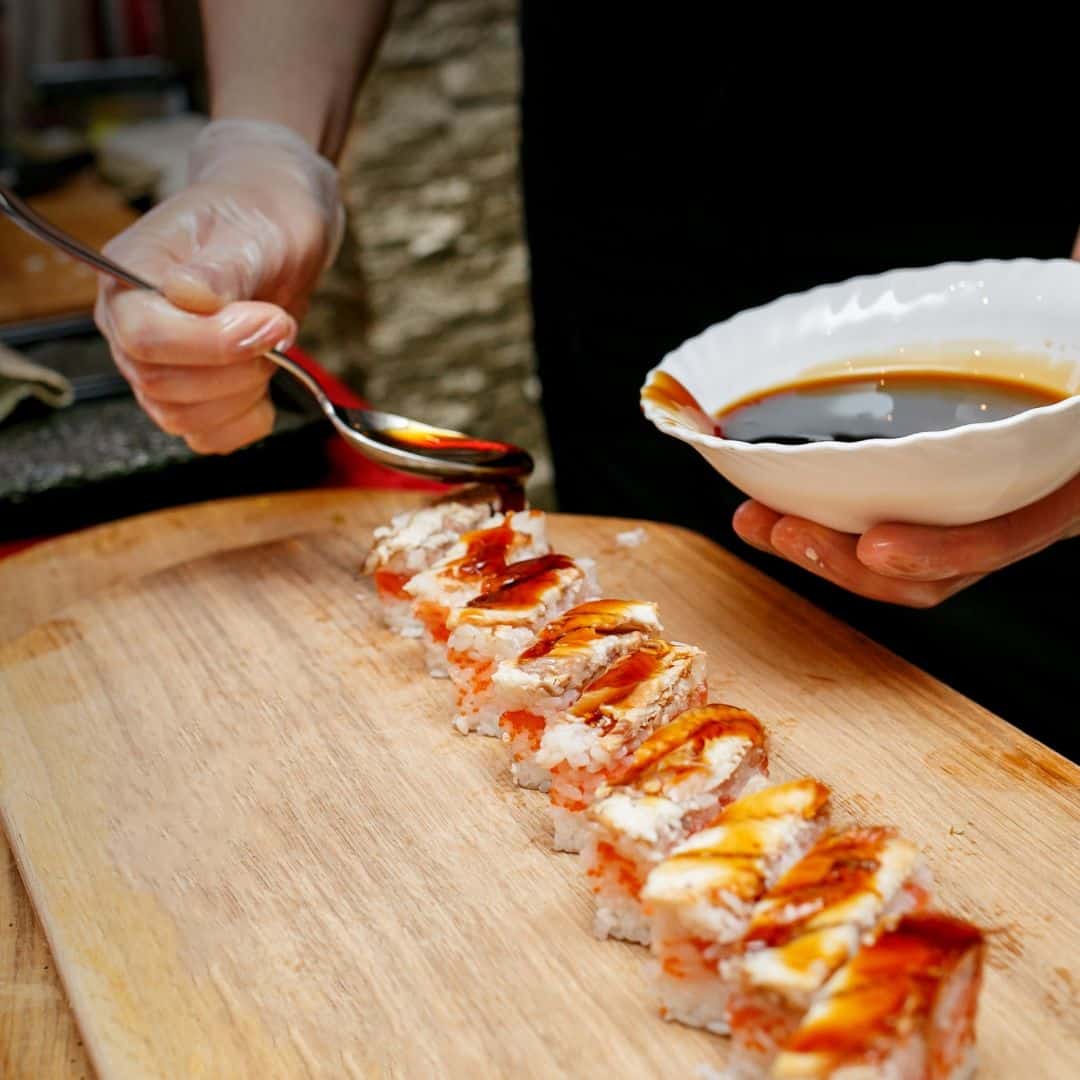
A wooden mold called oshibako is used to form the block-shaped sushi.
First, the chef places the toppings on the kitchen counter or baker’s table. Then, he covers them with sushi rice and later presses the oshibako down in order to create a compact oshizusi.
The sushi block is then removed from the oshibako and sliced into bite-sized pieces.
Saba zushi (鯖寿司) or battera, pressed mackerel sushi (バッテラ) is particularly popular in Osaka region. This type of sushi has all of its ingredients cooked or cured and the chef never uses raw fish.
Western-Style Sushi
There are also Western-style sushis which ingredients have radically been changed to fit the taste of Westerners and are entirely created outside of Japan. I think most people are familiar with the California roll or Dragon roll – that’s what we mean by western sushi. Those are not popular in Japan.
Well, to be precise Western sushi lovers actually borrowed the famous Japanese sushi dishes and evolved it with their own version of cooking and preparation techniques.
Here are the 2 most famous Western-style sushis:
Uramaki
Uramaki (裏巻) translated as “inside-out sushi roll” in English is mid-sized circular sushi that has at least 2 fillings. It is an analog of the California roll (a sushi preparation method to conceal the nori).
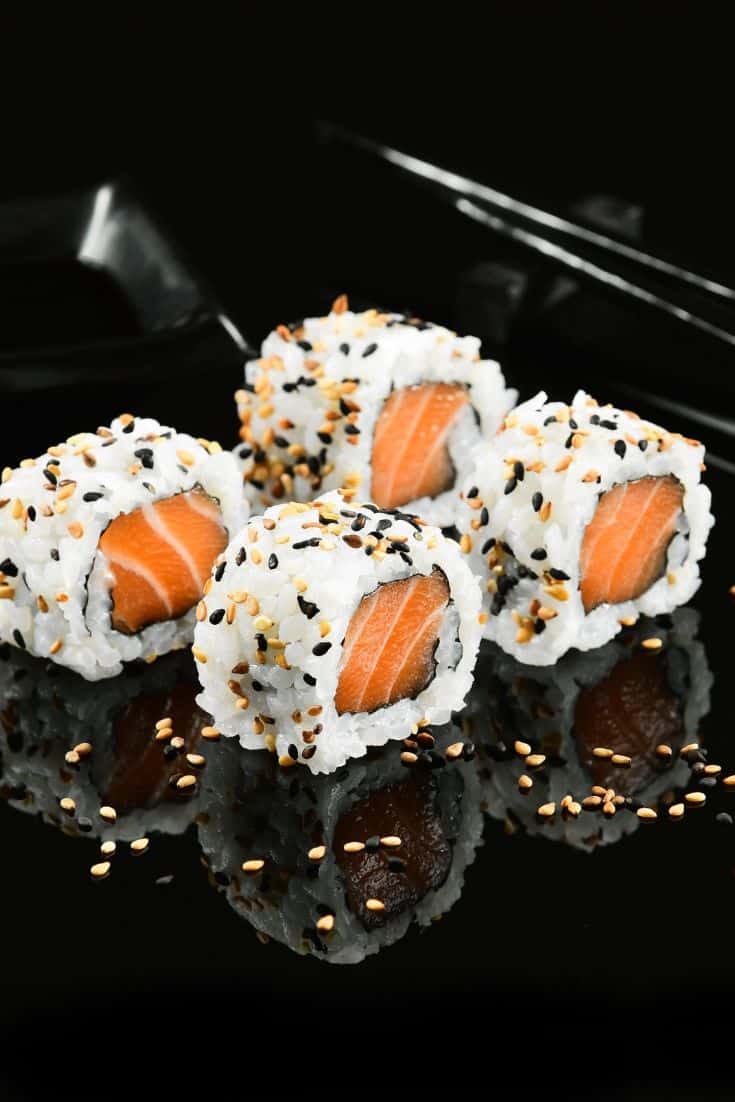
Although at first glance the makimono and uramaki may seem similar, they differ. For example, the uramaki has rice on the outer layer and the nori inside.
The uramaki’s fillings are in the center surrounded by a concentric ring of nori, rice, and other ingredients. These include toasted sesame seeds or roe which serves as an outer coating of sorts.
The uramaki has versatile ingredients for its fillings that includes carrots, cucumber, mayonnaise, avocado, crab meat, or tuna.
American-Style Makizushi
In the U.S. the futomaki is the preferred sushi. This is a variation of the makizushi that adopts the names of the places where each sushi originated.
There is an array of sushi rolls and may include dozens of different kinds of ingredients. An example is the tempura roll, where either the entire roll is battered and fried tempura-style or the shrimp tempura is stuffed inside the sushi roll as its filling.
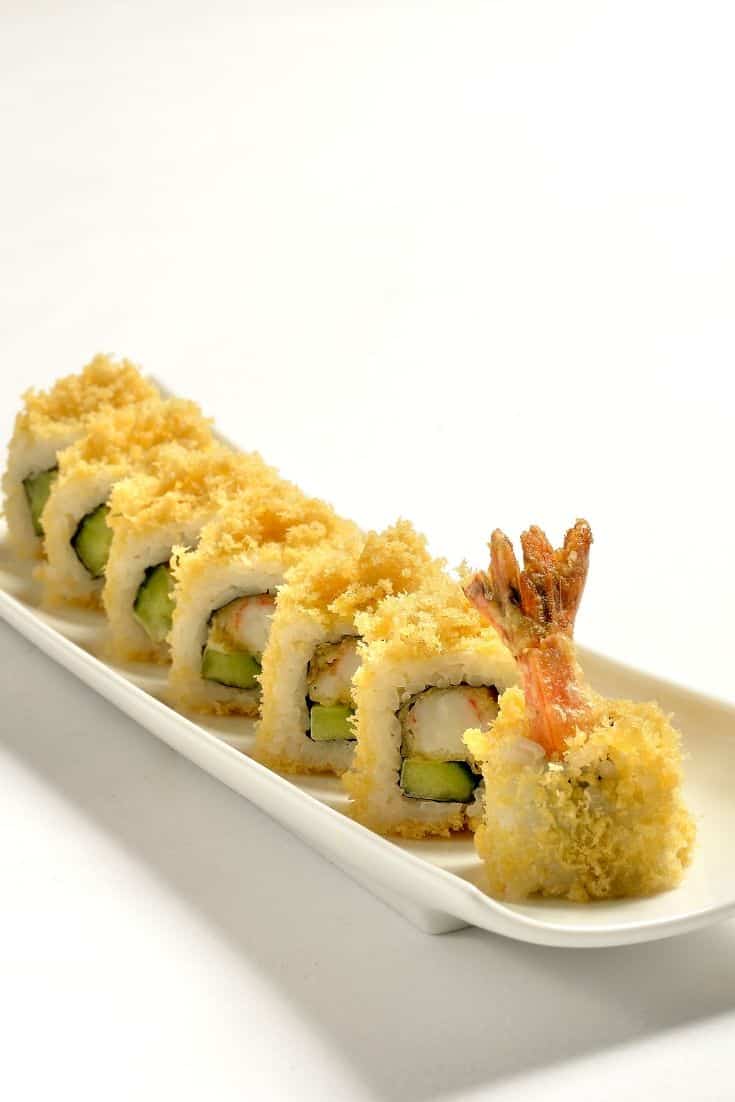
Other ingredients may also include assorted vegetables such as cucumber and avocado, okra, chicken or beef teriyaki roll, spicy tuna, and chopped scallions.
In the Southern United States, a lot of sushi restaurants prepare rolls using crawfish.
In some cases, the sushi rolls are made with black or brown rice that are akin to Japanese sushi recipes also.
More recently, vegetarian and vegan sushi is rapidly gaining popularity. Avocado and sweet potato are common vegan fillings.
Learn how to make Sushi for beginners
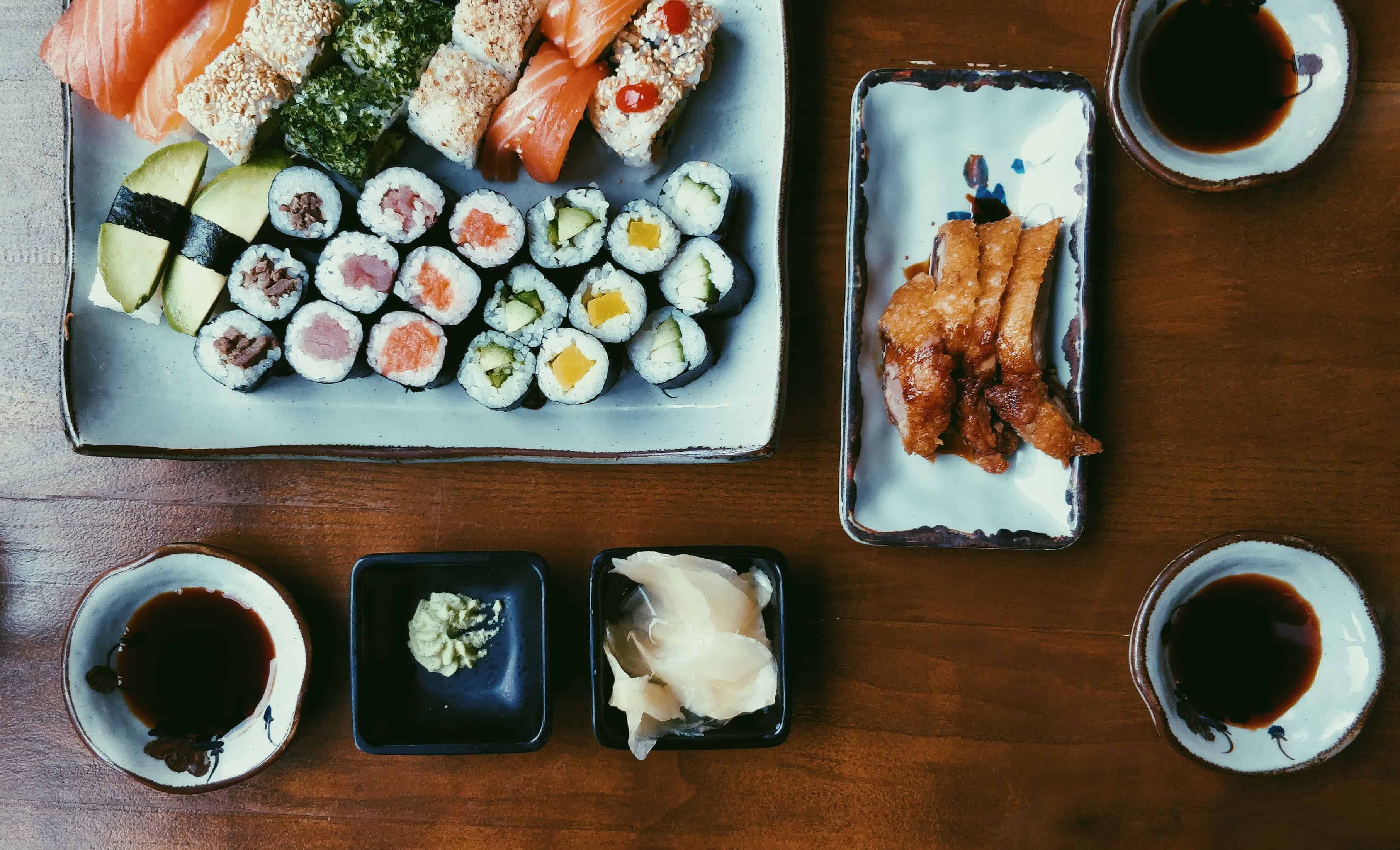
Now that you’ve learned a bit about sushi and the different sushi types, it is time to learn how to cook and prepare it yourself!
Unfortunately, if you genuinely want to prepare sushi as the Japanese do it, you will have to go through the basic, intermediate, and advanced courses to be as good as they are.
The stuff you read in sushi recipes and blogs and articles are not the complete method of making sushi.
No, most of them are the shorter versions of how to prepare sushi properly.
There is plenty of sushi making online courses available and most of them are surprisingly affordable too!
We’ve listed 5 websites that we’re confident will give you the best lessons on how to prepare sushi cuisines.
Top 5 Online Sushi Training Courses
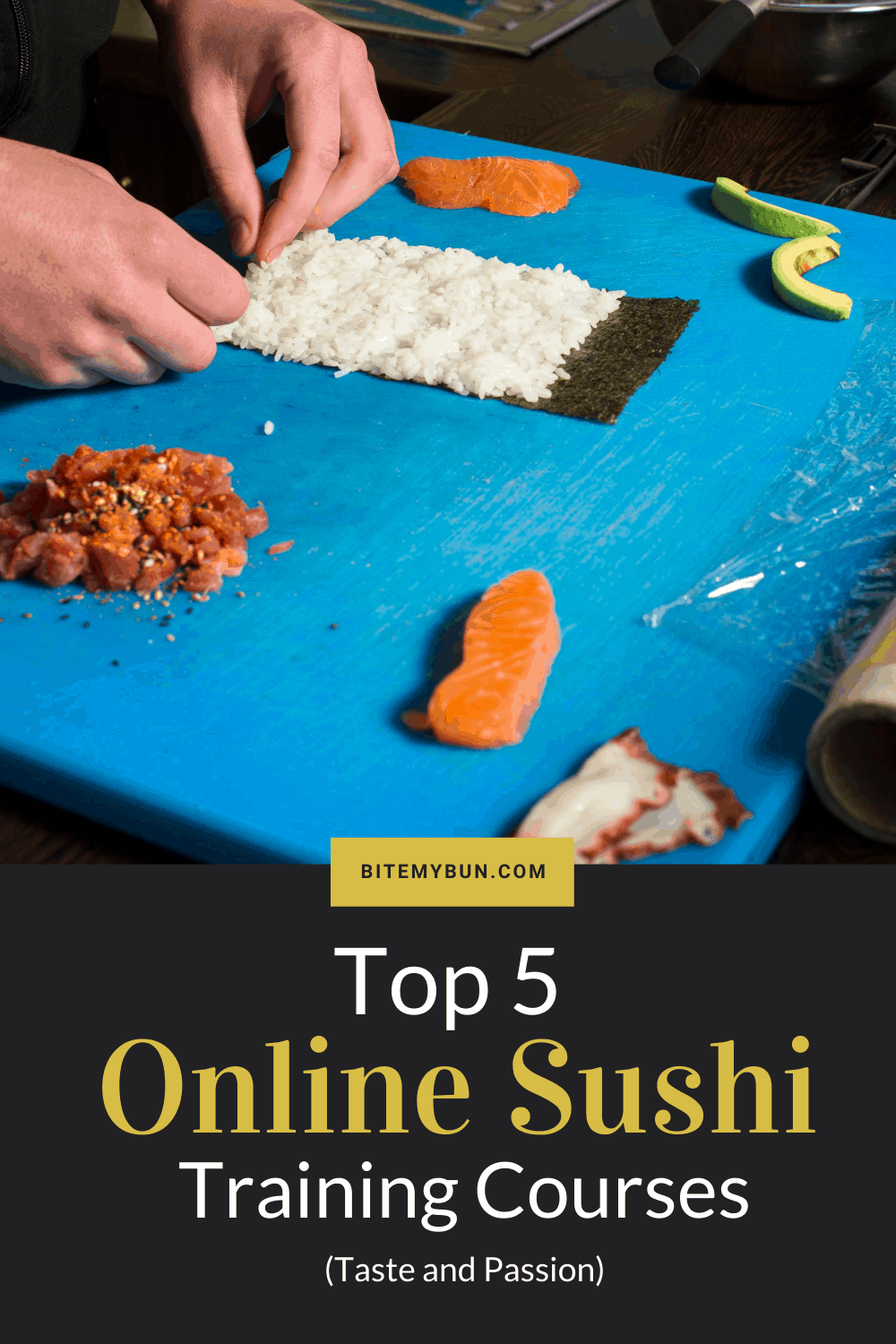
There are no shortcuts if you want to learn how to cook sushi dishes. So, prepare yourself and enroll in any of the online sushi-making courses below:
Most comprehensive sushi course on Udemy
Their “The Most Comprehensive Sushi Course Online” class over 247 ratings of 4.8 stars average and excellent reviews means they are living up to their promise.
This online sushi-making course takes you through the loops in creating the perfect sushi every time!
You’ll start at the basic level and then you will advance as you go through the modules and you’ll learn things like the different cutting skills, ingredient preparation, sushi roll fundamentals, how to make nigiri and sashimi, how to break down multiple species of fish, and much more.
Sometimes Udemy classes offer huge discounts, but only for a limited time, so, go check them out and enroll in classes that give huge price cut-offs!
You could get offers for as low as $20 on a 75% discount for a particular online class at Udemy just like the one we’ve mentioned above (take note that this offer expires within 4 hours from the time this article is published, so the pricing may change).
Still, that is so awesome! Gaining a ton of information on how to make sushi for such a small amount is like getting a Christmas present.
You can take a look at the course here
Make Sushi
This website offers sushi lessons for free! All you have to do is watch the videos on how to make sushi.
Chef Devaux has prepared 9 separate videos on all the processes involved in making sushis and this is only the beginning as he plans to upload more videos in the future.
The videos contain lessons on the things that you’ll need to cook, how to cut the meat and vegetables properly, preparing the garnish for the sushi, making the fillings, and many more!
You can also view the sushi making videos on his social media pages including YouTube, Facebook, Twitter, Pinterest, and Google+.
It’s time to become a modest sushi chef today! And, you know, the best part about it is that you’ve learned it all for free.
Sushi Courses on Skillshare
Skillshare is a US-based online learning community for people who want to learn from educational videos.
Right now there are 4 sushi courses being offered in Skillshare and all of them have talented world-class sushi chef instructors to guide you in becoming a great sushi chef too!
Classes like “Sushi Express: Learn How To Make Sushi In 60 Minutes or Less” and “A Way of Japanese Cuisine: Make Your Own Sushi Rolls” are great choices to learn sushi making online.
From knowing the differences between dishes – a complement to learning the tools of the trade you will be inundated with all the information you will ever need in making perfect sushi rolls.
Skillshare is available for free, for a premium subscription, and for teams – all of them are offered with a 1-month free trial.
The premium subscription costs $15 a month, but if you get an annual subscription, then you will only pay $8.25 for it, which will be billed on your credit card annually for $99.
The team subscription is also billed for $99 per student per year; however, there has to be a substantial number of students enrolled in the team in order for the class to proceed.
Yuki Gomi
Chef, food writer, and teacher, Yuki Gomi offers sushi courses on her website (which is self- titled) via comprehensive video tutorials that are easy to follow.
She has weekday and weekend classes, as well as afternoon and evening classes that are all for your scheduling convenience.
This means that you can certainly attend any of her classes no matter the type of schedule you have in your life, so you don’t have to make excuses when learning sushi from her.
You have the option to book whichever class you prefer. For example, there are sushi classes, home cooking classes, street food classes, workshop classes, and you can also book all classes and courses at one time.
You can also get gift vouchers to get discounts on classes and courses that interest you, and enroll in more online courses/classes for a much lesser amount than what you’ve anticipated.
SushiMagic.com
Here’s another website that offers free sushi lessons on demand! SushiMagic.com has around 8 how to make sushi lessons that you can read through and learn.
Although the course is short, you can learn many things from how to cook rice for sushi, to choosing the type of fish to make sushi, sushi rolls, nigiri sushi, sushi with meat fillings, sushi for vegans and vegetarians, making sauces and condiments, and how to sharpen the knives.
Plus you can also watch several of their YouTube videos posted on the site that shows you how to cut the fish, vegetables, and other ingredients.
Once again we would like to emphasize the greatest benefit of learning how to make sushi from websites like this – it’s absolutely free!
There’s nothing like getting something for nothing. You’ll instantly add new skills to your already impressive talent and become an even better person than you were before.
Start learning the magic of creating perfect sushi from Sushi Magic now!
Honorable Mentions
- California Sushi Academy (free)
- Fusion Fish Cuisine (free)
- Sushi Trainer (free)
Recommended Sushi books for beginners
Now that we’ve shown you the sites where you can learn how to prepare sushi dishes like a pro for either free or paid, it’s time to take some sushi “supplements” for your brain.
Becoming a modest sushi chef or cook requires 2 things, and those are a) learning by example (i.e. through video tutorials or blog posts) and b) learning by reading books about sushi.
Having said that, here are some books about sushi that we think you should read in order to become better at your trade:
The Book of Sushi
Author: Kinjiro Omae
Published: October 1, 1988
Long time chef and author, Kinjiro Omae, cataloged and displayed the ingredients, intricate preparation, and finished product of all the known Japanese sushi recipes.
He also discussed the “how-to’s” on the precision of making egg omelets, where to place things for rolls & cones.
The final section of his book entails the regional history of sushi, kitchen utensils needed to make it, and recommended restaurants in Japan.
Sushi: Taste and Techniques
Author: Kimiko Barber
Published: August 29, 2002
A very comprehensive book by Kimko Barber that will help you understand, master and appreciate the art of sushi.
Barber details in his book Sushi: Taste and Techniques information on how to find the freshest ingredients, how to use the appropriate kitchen equipment for the different sushi dishes that you’ll prepare, and how to master the etiquette of eating sushi correctly.
It’s the quintessential book that any Japanese food enthusiast will need in becoming a great sushi chef.
Check prices and availability here
Sushi: The Beginner’s Guide
Author: Aya Imatani
Published: August 1, 2009
A one-of-a-kind beginner’s guide that has taken the exquisitely popular Japanese dish to the next level in terms of easy to digest presentation and stunning photography.
Expert sushi chef Aya Imatani takes would-be chefs by the hand through super clear close-up photos, leading them through every delectable step of the sushi-making process.
Also read: this is how you create beautiful food photos, ready for sharing
She talks about all the tools, foods, and paraphernalia from experience and demonstrates a new process to make sashimi that has not yet been introduced in sushi restaurants!
Even her kinds of vinegar and dipping sauces are unique. You can’t find them on the internet.
You can check out the book here
Edomae Sushi: Art, Tradition, Simplicity
Author: Kikuo Shimizu
Published: June 1, 2011
“Edomae” means the Edo Bay or Tokyo Bay. During the Meiji Era local fishermen would catch fish and other seafood right off of Edo Bay and from this catch sushi was made, thus the term Edomae sushi was coined.
Over the years shipping lanes and pollution from factory refuse and sewage water being dumped into the bay area made fishing undesirable.
Edomae sushi – which was considered a unique and highly-esteemed cuisine – gradually faded into obscurity, until Kikuo Shimizu revived it in his book.
Written records of Edomae sushi are scarce; however, the sushi preparation technique and soul were successfully handed down from generation to generation of premiere Japanese chefs and Shimizu is one of those chefs.
Sushi at Home: The Beginner’s Guide to Perfect, Simple Sushi
Author: Yuki Gomi
Published: July 30, 2013
Seasoned Japanese chef Yuki Gomi published a cookbook about how to make sushi at home and she makes it seem easy.
Sushi at Home: The Beginner’s Guide to Perfect, Simple Sushi does indeed make sushi preparation east thanks to Chef Gomi’s streamlined approach in demonstrating it in her book.
Through the help of high-quality images and simple to understand instructions you’ll be able to prepare your first sushi recipe just half-way through reading the book.
Check out these top rice cookers as well when getting into sushi
Guide to Eating Sushi for Beginners
When you first visit a sushi restaurant, the experience can feel a bit overwhelming. There are so many types of sushi available, how do you know what to choose? You might even feel nervous and confused about how to eat sushi.
In this section, we’ll teach you the basics of eating sushi and help you decide what to order.
Most Common Fish and Seafood in Sushi
- Salmon
- Tuna
- Yellowtail
- Crab
- Shrimp
- Octopus
- Flatfish
- Cockle
- Sea bream
- Scallop
- Halfbeak
- Trout
- Eel
- Clams
- Squid
- Sweetfish
- Swordfish
Now depending on your preferences, you can pick the type of seafood you like most. And if you just don’t like seafood, especially raw fish, chicken is also a popular filling. Then, there are many vegan and vegetarian varieties with tofu, sweet potato, avocado, and more to choose from.
The Sushi Restaurant Experience
Sushi restaurants are all a bit different, but the basic experience is the same. The setup differs from place to place, but we’ll share the basic tips to help you maneuver this new dining experience. After all, eating sushi is all about sharing a tasty culinary experience with friends and family and there’s no need to get caught up in the small details.
Here are a few unwritten rules to know:
- The server brings a plate with your order of sushi rolls
- You also get chopsticks
- There is a bottle of soy sauce on the table (or small packets)
- If you see an extra plate, that is for appetizers
- You eat the sushi with the chopsticks or your hands
- In the West, you can ask for a fork
- Some restaurants offer extras like side salads and miso soup
Once the sushi is served, you will have 4 things on the table:
- Sushi rolls
- Soy sauce
- Wasabi
- Pickled ginger
Can I eat sushi with my hands?
Many people, especially Westerners are worried about eating sushi with their hands. It’s a dilemma – what if I can’t use chopsticks? Can I use my hands? Is it rude?
The good news is that according to Japan today, it’s completely acceptable to eat sushi with your hands. There is no proper way to eat sushi but the important thing to keep in mind is that if you use your hands, only grab and touch what you eat.
The reason that chopsticks are so handy is that they are a sanitary way to eat. You can pick up the small pieces of sushi and ginger without getting rice and fish all over the table.
What is wasabi and pickled ginger and how to eat them?
So, you might be wondering what that green paste and the small ginger strips are. Well, the green paste is called wasabi and it’s a spicy pungent paste, like horseradish. It is spicy but not like peppers, it has that throat and sinus decongesting effect and a slight burn that goes away after a minute.
The pickled ginger is served as a palate cleanser. It has a mild and soothing flavor that takes away that burning sensation of the wasabi. As well, it clears the flavors of your last sushi roll to make room for the next roll. This allows you to fully taste the flavors of the food.
How to eat sushi
Here is a beginner’s guide to eating sushi. Just remember the key steps mentioned below and you’ll be fine.
- Receive your plate with your sushi order.
- Place a small amount of soy sauce onto the edge of the plate or in a sauce bowl (if it’s provided).
- Dip your sushi roll into the soy sauce. The point is to avoid soaking the roll in the sauce. If you really want extra sauce use the chopsticks to place a bit more onto the top of the roll.
- At this time you can add wasabi too with the chopsticks.
- Try to eat the sushi roll in one bite. If it’s a bigger roll, then it’s acceptable if you eat it in two or three bites.
- Chew the food well and have a sip of your drink now. We recommend trying sake if you like alcohol.
- After each roll, take a small piece of pickled ginger and eat it to cleanse your mouth.
- Now continue eating until you finish all your rolls.
FAQs about Sushi (For Beginners)
If you still have questions about sushi, check out our frequently asked questions and answers.
What sushi should I try for the first time?
Many people are nervous about trying sushi for the first time. Some people are concerned about the raw fish. That’s why we recommend something very popular and ‘Americanized’ such as the classic California Roll. It’s best for beginners because it contains simple ingredients like cooked crab meat (or imitation), cucumbers, and avocado.
Another popular option for beginners is the spicy tuna roll because it only contains tuna and spicy mayo, and most people are familiar with the flavor of these foods.
What kind of sushi is cooked?
Contrary to a popular myth, a lot of sushi is actually made with cooked fish and seafood. So, not all sushi is raw. The California Roll, the Tempura Roll, and anything with eel (unagi and anago) are always cooked.
Tip: look for rolls with the word tempura in them because tempura means the fish is dipped in a batter and fried, so it’s not raw.
Will I like sushi if I don’t like fish?
Yes, there are types of sushi that don’t contain fish and seafood. For example, vegetarian and vegan options use tofu or vegetables as substitutes. There are honestly so many plant-based and fishless alternatives as well as chicken and beef sushi rolls. It’s more important that you like rice. If you don’t like rice you won’t like sushi.
How many rolls of sushi is a meal?
Sushi is a food that’s meant to be shared in a collective setting. For that reason, you’ll notice that sushi catering restaurants offer large sushi platters and sushi boats.
One sushi roll is usually made up of 6 individual small rolls. So, 6 pieces per person is a good rule of thumb to keep in mind.
Why is sushi eaten raw?
So many of the sushi rolls you find contain raw fish. The raw fish you eat at the restaurant is usually fished in cold waters and then freeze before it’s made into sushi. The freezing process is essential because it kills the potential parasites in the fish.
However, keep in mind that eating raw fish always implies a small risk.
Do you eat sushi cold or warm?
The sushi rolls are usually served at room temperature. It’s most comfortable to eat sushi that way. If it’s too cold it hurts your teeth and nobody wants a burn, so sushi is not hot either. Plus, if you cool the rice, it destroys the rice texture.
Therefore, you eat sushi at room temperature. Now, the fillings can be hot or cold. If the roll contains raw fish, it is cold. If it contains cooked seafood like eel, it will still be warm.
What is the healthiest sushi roll to get?
When it comes to nutrition, sushi is generally quite healthy food.
Here are the top picks when it comes to healthy sushi (of course, you can always make this sushi without rice).
- Cucumber Roll (on Brown Rice)
- Sashimi
- Salmon-Avocado Roll (on Brown Rice)
- Rainbow Roll (on Brown Rice)
- Avocado Roll (on Brown Rice)
Brown rice is the healthiest option because it has fewer calories.
Conclusion
Sushi is always evolving. Modern chefs are constantly inventing new recipes, swapping ingredients, and making new vegan options. So, there’s no need to worry about eating sushi because, with so many new options, you can find something to suit your taste.
One of the most important things to keep in mind is that sushi is a unique culinary experience. There are so many flavors, it’s best to eat the rolls slowly and savor every flavor.
Also read: these are the best sushi kits to ger started
Check out our new cookbook
Bitemybun's family recipes with complete meal planner and recipe guide.
Try it out for free with Kindle Unlimited:
Read for freeJoost Nusselder, the founder of Bite My Bun is a content marketer, dad and loves trying out new food with Japanese food at the heart of his passion, and together with his team he's been creating in-depth blog articles since 2016 to help loyal readers with recipes and cooking tips.


